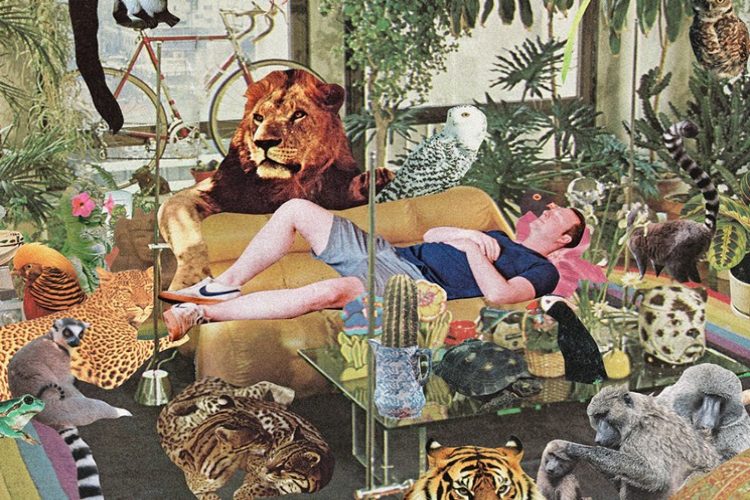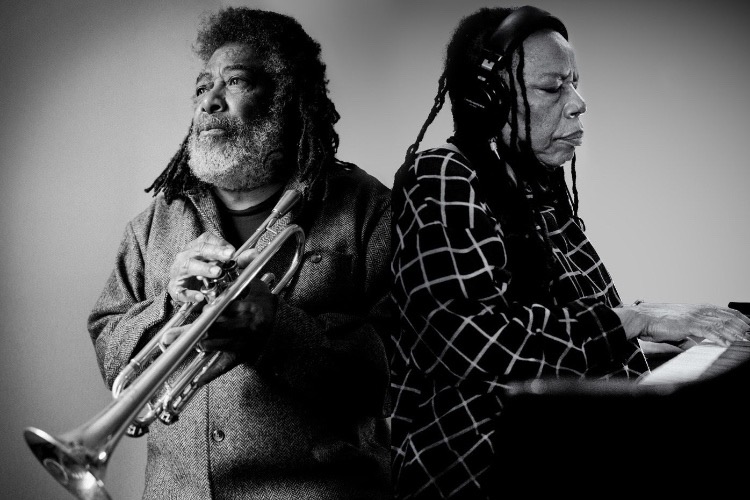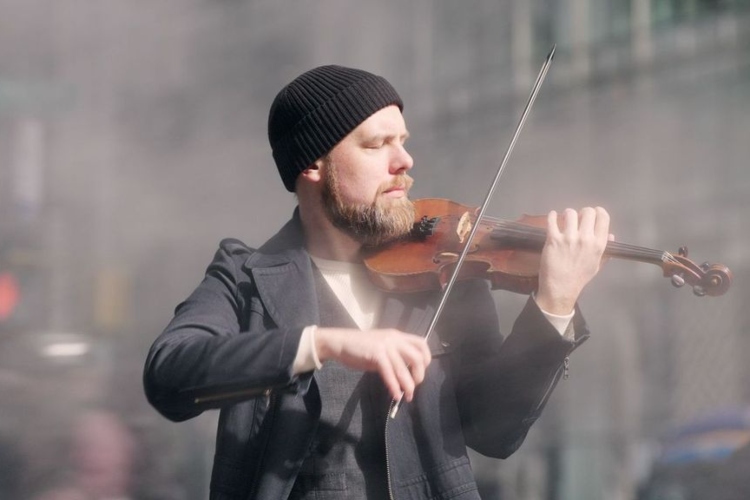Castaway to an Imaginary Vacation: Ted Feighan on Monster Rally and his Creative Process
|
Getting your Trinity Audio player ready...
|
In both his striking visual art and his eclectic music, Ted Feighan engages in a collage making process. In the former, he does this by surrounding the natural beauty of exotic birds and flowers with vibrant colors and, occasionally, man-made objects like couches, cars, or buildings. In addition to their own artistic merit, they also serve as wonderful album art. His recordings – primarily issued under the name Monster Rally – similarly sample sounds from decades past and fuses them into a whole that is difficult to place in both locale and time. Due to Monster Rally’s aesthetics, some may mistakenly apply the label “exotica” or, due to his method, “instrumental hip hop.” And while influences of both are present, it is erroneous to box his sound into either, as it draws from both and many other concepts. Instead, he sees his sound as essentially forming a soundtrack for a vacation the listener has never taken. Even the Monster Rally name suggests something out of the normal, having been derived from a book by Charles Addams featuring his Addams Family characters. We had an opportunity to sit down with Ted to discuss his creative process, his inspirations, and Castaways Vol. 1 (Gold Robot Records, 2020), a collection of works that were not previously released on vinyl.
PostGenre: 2020 marks your 10th year as Monster Rally. What do you feel like you’ve learned the most from the past decade in terms of music?
Ted Feighan: What I’ve learned the most is how long it takes to reach new people for an audience. In the beginning, I was working under the mindset that you have only a set period of time during which you must find success in your career as an artist or that you never would. I remember when I started down this path, I read a lot about Brian Wilson and how he made such great music when he was 21. Since I started at age 22, I knew that was never going to be my story [laughing]. Early on, I thought that I’d have either blown up big career-wise or just be done with making music professionally because there was no way the life cycle of music would take more than years. But ten years into Monster Rally, things just keep getting better in terms of listenership and all that sort of stuff. Every year is better than the one before. The truth is that sometimes the cycle does take that long. And even then, you’re lucky if it does. It also just takes longer, in general, for most musicians than it used to. Now, I am very happy to be able to be continuing to make my music and that people are interested in listening. I’m really excited for the next decade.
PG: As far as your music, what can you tell us about your process? Some of your works have clear a narrative. Do you craft that story beforehand and then tie pieces together to fit it, or do you come up with the sound first and form the story around it?
TF: I’ve done both. But usually, I have a narrative in mind and then make tracks that were informed by that. Generally, my music-making process is focused on discovering sounds.
I will sometimes just find an album at a record store or thrift shop or even in my own collection from something I may have overlooked. To be honest, this part has been more difficult since I moved to Cleveland. When I lived in LA, I used to go to Amoeba Records and dive into the world music section, then the easy listening section, really anywhere in that store. Each would have a dollar album area. I would go in and buy like 50 World Music albums for $50. Then I would go home and go after anything I bought that looked interesting. There were some real gems in some of those discount recordings. It’s just funny because the fact it was discounted might suggest that people didn’t want or maybe forgot about those albums, but there was some really incredible stuff in there. And, sometimes in this process, you would find something that most people just forgot about and you can put a new life into it by presenting it differently than before, even if you are only using a few seconds of it.
I will find these sounds that are interesting to me- new or intriguing sounds mostly – and begin recording those and piecing them together in a way that makes sense for the narrative arc of what I was thinking about. Sometimes I add transitions in between them to make them flow better, but not always.
PG: How do you determine ahead of time whether recordings would work well together?
TF: A lot of it is just being in the moment. My setup is very simple, I just have two samplers, a handful of percussion instruments, and a few other things that I’ll use. Usually, my music-making is largely a cut and paste process with different things I have collected. Sometimes I’ll be working on something and might like how the two samples sound together, but feel like they won’t necessarily otherwise fit in the same song. On another set maybe it makes sense to have those two samples together. There have also been a lot of times where I liked something in the moment but then once I listened to it, even though I enjoyed the moment of making it, it just didn’t click.
One thing that happens to me all the time is that people ask what specific samples I’ve used in a particular piece. But most of the time, I don’t remember where they’re from originally because of my process. I’ll put them on the sampler and by the time I go to use them, I often don’t remember where they originally came from. I mean there are definitely some I remember. The song “In the Valleys” from Mystery Cove (Gold Robot Records, 2016) samples a specific Don Ho recording, for instance. But a lot of the time my memory isn’t as great. I am more likely to remember who it is if it is someone that was an inspiration of mine and that I look up to.
PG: Who are some of your inspirations?
TF: Obviously, as I mentioned earlier, I still love Brian Wilson and am a huge Beach Boys fan. He’s always been a very important person to me. I also love Madlib. Back in the day when I was first starting this, my whole vision was to try to be like a Tropical Madlib. I was obsessed with his music and started focusing on technical things like what type of sampler Madlib uses. He’s a really big influence in terms of style and hip-hop production. For the same reason, I also love DJ Premier. Q-TIP’s productions are also so good. He doesn’t get enough credit for them, but they’re great. I also really love Fela Kuti, who is a big inspiration of mine. And then, of course, there are the guys like Martin Denny or Arthur Lyman who are really big for me as well.
PG: As to the Denny and Lyman, I think some people place their sounds into this sort of exotic or tropical box. Do you consider your music to be a continuation of that sort of mindset?
TF: It’s interesting because I don’t set out with the mindset of “this is going to sound tropical.” There is nothing tropical seeming about my sampling process or how I piece things together but there is also often a sort of foreign and mysteriousness to how the recording ends up sounding. It’s not necessarily a conscious thing at all, yet the aesthetic just kind of finds its way into the music. And I think that the kinds of samples and sounds that I’ve drawn to sort of lend themselves to that kind of tropical element. But, at the same time, I don’t really try to push my music into a specific box. There are so many different kinds of music out there. In a way, I am lucky because the sampling process allows me to just sort of pull from a bunch of different stuff that I like, even if they’re don’t sound similar.
PG: What can you share about Castaways Vol. 1?
TF: Castaways features pieces that have never been released before on vinyl. Hunter [Mack; founder of Gold Robot Records] and I have had lengthy conversations about how to try to get these tracks released on vinyl. We have had a few people request them on vinyl and it sort of made sense to produce them together as a separate album; an album of ideas that were essentially “cast away” from the final albums. We thought it would be kind of cool to put them into specific little packages like this instead of just sort of a random collection of tracks. We actually have enough additional ones to release a second volume sometime in 2021.
PG: When a cynic hears about tracks that didn’t make an original recording, they may think they are somehow inferior, but that’s not at all how these sound.
TF: Yes. The existence of extra tracks is really because of my process. When I record something, I usually will need, say 15 or 18 tracks, but end up usually making around 30 of them. The ones that don’t end up on the album aren’t reflective of their quality but instead how well they fit the entire arc of the record and whether they make sense next to the other tracks. So, it’s not at all that I didn’t like them enough but instead that they just didn’t fit that particular context. That’s how a lot of these extra tracks ended up leftover at the end of the day. And it becomes hard to include them on other albums for the same reason. The ones I brought out for Castaways are the best of those tracks that just didn’t fit other albums.
PG: Although they weren’t initially intended to be presented this way, the tracks on Castaways, Volume 1 often seem to fit well together. Did you have to change them at all to make them fit better or did that occur naturally?
TF: Hardly anything changed since they were originally completed. I mean, there were some changes. Now they will be mastered for vinyl when they were not before. There are a few where maybe I went back and changed the drums slightly or cut them to be a little shorter or make them slightly longer. But there weren’t any massive changes.
PG: One thing that is interesting is, and part of it may be from your sampling, is that it seems your music often jumps around between eras. Sometimes it sounds current yet also a little antiquated; paradoxically both modern and older. What are your thoughts on this aspect of your music?
TF: Yeah, I think that initially I was just drawn to older sounds through the recordings I was sampling. There is the idea that the past can sometimes be comforting and the future a bit scary because it is unknown. But of course, the past isn’t always as comforting as some people may suggest and the future can also be optimistic. So, it is kind of interesting to sort of bridge the two.
Initially, I was just like finding these records that I liked and because they are older, an older aesthetic is sort of inherent. I am also inherently a fan of vintage sounds. But I’ve been more interested in the concept of essentially making music from a vacation that you never took. And part of that is feeling something from the past that you actually never experienced. It is sort of like how through shared cultural history, you feel like you understand and know about the past but you did not live through it so do not actually have a concrete idea about how it actually was.
PG: How do you view the relationship between your music and your visual art? Are they distinct things entirely or sort of continuations of one another?
TF: They are very tied together. Or at least, the artwork and the music I am making right now are to one another. Both processes started around the same time and both occupy the same space in my mind. Generally, I don’t feel like there is a divide between my music and my artwork.
At the same time, Monster Rally is- and I hate to say this- a bit more rigid in its concept than my artwork. While I have a lot of the same ideas for both, the artwork is more open because I can put it out in a more casual manner and try things that I wouldn’t necessarily release in an official process like with my albums. I am 10 years into making Monster Rally albums and it is sort of an established concept. Sometimes I will make music and some of the songs I record I think are great but don’t really fit the “Monster Rally” concept. For instance, I have made some tracks which sample from 70s soft rock kind of stuff and I love how it sounds but it isn’t “Monster Rally.”
PG: Have you considered releasing these other projects but maybe under a different name?
TF: Yeah, I have. I have an EP lined up under a different name that I haven’t released. Maybe I will. The funny thing is that when I play it for my friends, they tell me that I don’t know what I’m talking about because it sounds just like a “Monster Rally” song [laughing].




One thought on “Castaway to an Imaginary Vacation: Ted Feighan on Monster Rally and his Creative Process”